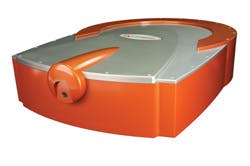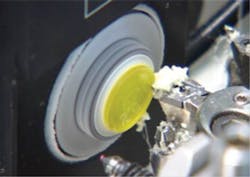Near-perfect micromachining reduces post-processing stages
By Eric Mottay
As early as 1995, ultrafast lasers were recognized as good sources for precision micromachining. Because of their extremely short pulse duration, virtually no heat diffusion occurs during the interaction, leading to a high processing quality that is free from thermal effects such as cracks, burrs, and melting.
However, the Titanium Sapphire ultrafast lasers widely in use at the time were generally ignored for any serious industrial use and were considered as slow, expensive, unreliable, and difficult to use.
The advent of Ytterbium ultrafast diode-pumped lasers at the turn of the century has dramatically changed the landscape. Initially developed by a few pioneering companies, later joined by a growing number of manufacturers, ultrafast lasers have evolved into robust industrial tools. They have seen average power increase a hundredfold in the past decade and are today used in many different applications, from eye surgery to advanced display and micro-electronics.
Inroads into tradition
Now well accepted in these demanding sectors, ultrafast lasers are making significant inroads into more traditional micromachining applications, competing against more mature, less expensive technologies. How can this be?
As an example, let us look at the field of medical device manufacturing. Medical devices are high-added-value components, with stringent requirements in terms of product quality, and very often require challenging industrial manufacturing process. Device manufacturers make extensive use of advanced technologies, including lasers, electrical discharge machining (EDM), and additive manufacturing. The extremely high-quality requirement makes a strong case for the use of ultrafast lasers, but it seems at first sight that other technologies may keep an edge in terms of initial investment cost or processing speed.
Stents are the most well known laser-manufactured medical device. A stent is a prosthesis made either of metal or polymer used to restore the blood flow in an obstructed artery. In this application, laser cutting offers both quality and versatility and is today the reference process for stent manufacturing.
Today, metal stents are mostly processed by long-pulse lasers, typically with microsecond or nanosecond pulse duration. The manufacturing process includes laser cutting, but significant post-processing (deburring, post-polishing) cleaning is required. The total manufacturing cost includes amortization of laser investment, laser operating costs, and post processing costs. Ultrafast lasers have typically higher investment costs than other technology. However, they have low operating costs, and the high processing quality made possible by the femtosecond pulse duration significantly reduces the post-processing costs, which represent a significant part of total manufacturing cost. In addition, continuous improvements in laser power and repetition rate have, over the years, significantly increased process productivity. Improvements are expected to continue in the future.
Cataract surgery
Another significant example involves the manufacturing of intra-ocular lenses (IOL) used after cataract surgery to restore accommodative power to the eye. Cataracts is one of the most common ocular diseases, with more than 3 million procedures performed annually in the US alone. It is characterized by a gradual opacification of the crystalline lens, leading to blurriness and loss of vision.
The procedure to treat cataract problems consists of destroying and removing the crystalline lens, leaving its containing capsule intact, and inserting a polymer artificial lens (IOL) to restore accommodation. The procedure consists of three main steps:
- Open the capsule to gain access to the lens
- Destroy the lens using high-frequency ultrasounds and remove the lens debris.
- Insert the IOL into the now empty crystalline lens capsule.
To achieve maximum efficiency, it is important that the lens is centered in the capsule. This in turns depends on the precision (centering, circularity) by which the opening cut is made by the surgeon.
Femtosecond lasers are increasingly used to accomplish the full procedure to cut the various incisions in the cornea and the lens capsule. Because of their high precision, the centering and circularity of the cut are close to ideal. Femtosecond lasers also allow the cutting of the crystalline lens, therefore reducing or in some cases eliminating the need for intrusive ultrasounds in the eye.
The final stage of the procedure consists of the insertion of an IOL in the now-empty capsule. An IOL consists of a polymer lens with centering struts, called haptics. In work conducted in partnership with Physiol, Belgium, the current manufacturing process is based on a mechanical diamond lathe and milling. Lenses are typically manufactured in batches of 60. Since the polymer is extremely soft, it does not lend itself well to mechanical machining and needs to be cooled down to cryogenic temperatures (typically -15°C). Even so, tool wear occurs, and the diamond tool needs to be replaced every few hundred operations.
Because the lens will be inserted in a human eye, it is extremely important that no shaving or defect remain after the process. This involves a number of post-processing stages, such as polishing and cleaning, which take place after the milling process.
Reduced process time
Laser microprocessing, being a noncontact process, is a very attractive option to eliminate tool wear, and to operate at ambient temperature. Over the years, a number of laser sources have been tested, from CO2 lasers to UV nanosecond lasers. However, none of these processes has achieved sufficient quality to allow a transfer in production. The most obvious drawback is burning of the polymer that is very sensitive to thermal interaction.
Amplitude Systèmes, along with its Belgium partner Lasea, has developed a micromachining process using an industrial ultrafast laser to address this. It became apparent very early in the development process that ultrafast lasers provide an excellent final quality, without the need for extensive post-processing. Regarding the question of process time, our reference was the mechanical manufacturing process time on the order of 1 mn.
Initial results led to a laser process time of approximately 90 seconds, which was from the start very competitive, considering the gain in total production costs due to the absence of post-processing. Further work, including the development of a high-speed scanning system by Lasea, the use of a higher average power ultrafast laser, and optimization of process parameters, led to a process time on the order of 30 seconds, i.e., half the mechanical process time.
Ultrafast lasers have come a long way since they were sophisticated research tools. Their ability for near perfect micromachining quality reduces or eliminates expensive post-processing stages. Further advances in laser power, high-speed beam delivery, and advanced material processing mean that ultrafast lasers have a bright future in industrial manufacturing.
Eric Motay(emotay@amplitude-systèmes.com) is the president and CEO of Amplitude Systèmes, Pessac, France.
More Industrial Laser Solutions Current Issue Articles
More Industrial Laser Solutions Archives Issue Articles

